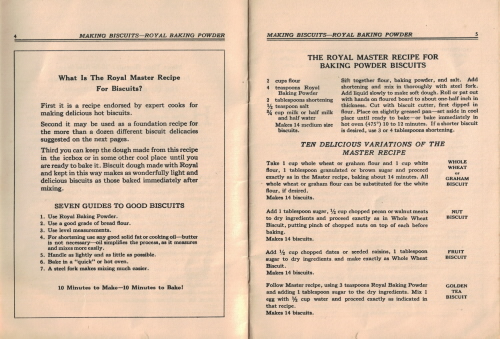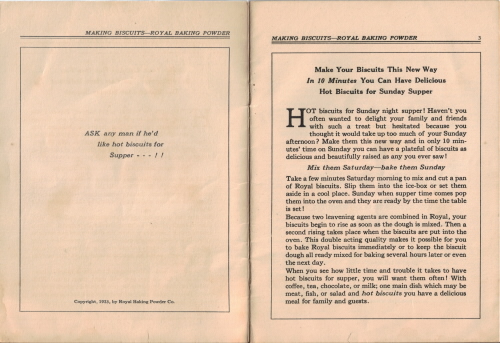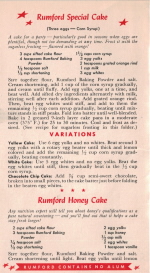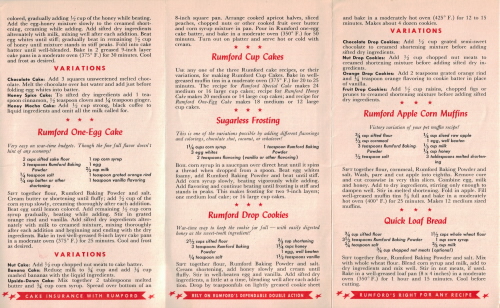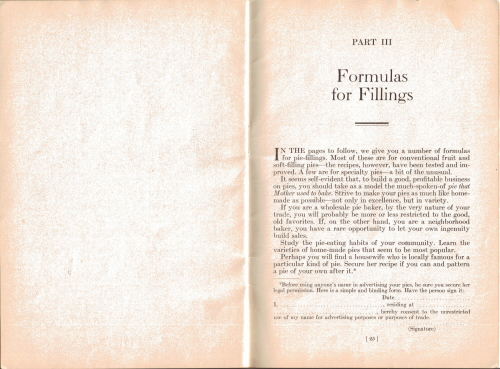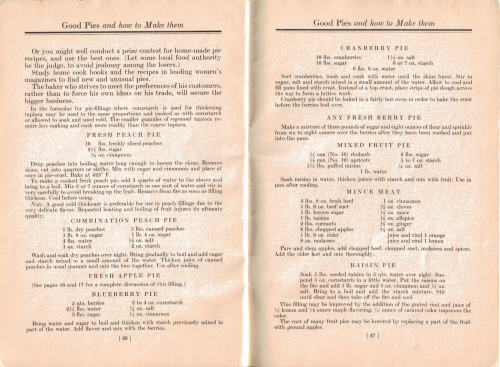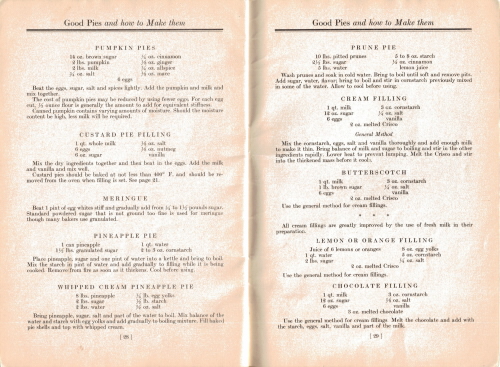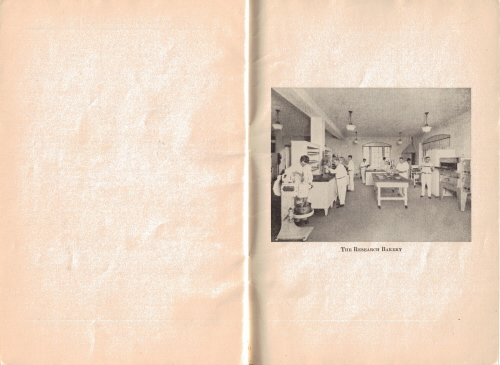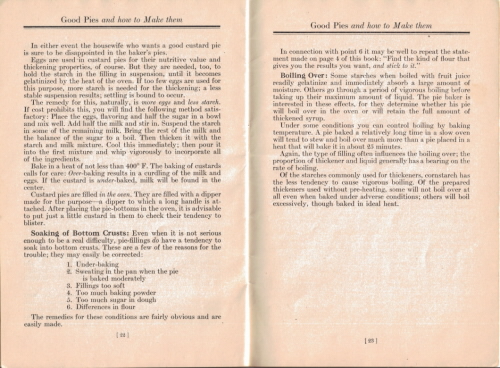 Here are pages 7 and 8 of the 1923 recipe book “Making Biscuits” by Royal Baking Powder Co.
Here are pages 7 and 8 of the 1923 recipe book “Making Biscuits” by Royal Baking Powder Co.
To review the entire book, just visit the Making Biscuits: Royal Baking Powder category and click a page title to view that section.
All images below are clickable if you’d like to see a larger copy.
OTHER KINDS OF BISCUITS
ORANGE BISCUIT
 2 cups flour
2 cups flour
1 tablespoon sugar
1/2 teaspoon salt
4 teaspoons Royal Baking Powder
3 tablespoons shortening
3/4 cup milk or half milk and half water
Sift dry ingredients; add shortening and mix in with fork. Add liquid slowly to make soft dough. Turn out on floured board; roll or pat to 1/2 inch thick. Cut out with small biscuit cutter and put on greased pan. Press gently into center of each biscuit a loaf of sugar which has been dipped well in orange juice. Grate a little orange rind on each and bake in hot oven (475°) about 15 minutes. Makes 15 biscuits.
EMERGENCY OR SOUR MILK BISCUIT
2 cups flour
4 teaspoons Royal Baking Powder
1/2 teaspoon salt
1/4 teaspoon soda
4 tablespoons shortening
3/4 cup sour milk
Sift flour, baking powder, salt, and soda together. Melt shortening, add to sour milk and add this liquid to the dry ingredients. Mix to make a soft dough. Turn out on slightly floured board. Roll or pat out to 1/2 inch thick. Cut with small biscuit cutter and place on slightly greased pan. Bake in hot oven (475°) for 12 minutes.
Buttermilk can be used instead of sour milk. Makes 16 biscuits.
BUTTERSCOTCH ROLLS
2 cups flour
4 teaspoons Royal Baking Powder
2/3 teaspoon salt
4 tablespoons shortening
2/3 cup milk or water
butter
brown sugar
Sift dry ingredients; add shortening, mixing it in with a fork (if liquid shortening is used, add with milk). Add milk to make a fairly soft dough. Knead slightly and roll out 1/4 inch thick. Spread well with creamed butter and brown sugar. Roll up as for jelly roll; cut in 1 inch pieces. Stand these on end in a well buttered pan, or in small greased muffin rings and bake in a moderate oven (375°) for 30 minutes. If desired, pecan nuts may be sprinkled in before rolling. Makes 12 rolls or 22 if baked in small rings.
SCOTCH SCONES
 2 cups flour
2 cups flour
3 teaspoons Royal Baking Powder
1 teaspoon salt
2 tablespoons sugar
3 tablespoons shortening
2 eggs
1/3 cup milk
Sift together flour, baking powder, salt and sugar; add shortening and mix in very lightly. Beat eggs until light; add milk to eggs and add slowly to mixture. Roll out 1/2 inch thick on floured board; cut into pieces two inches square and fold over, making them three-cornered; brush with milk; dust with sugar. Bake on greased pan about 25 minutes in hot oven (400°). Makes 15 scones.
POTATO BISCUIT
1 1/2 cups flour
4 teaspoons Royal Baking Powder
3/4 teaspoon salt
4 tablespoons shortening
1/2 cup cold mashed sweet or white potato
1/2 cup milk
Sift together flour, baking powder, and salt. Add shortening and potato, mixing in with the dry ingredients. Roll or pat out with hands on floured board to about 1/3 inch thick; cut with small cutter; bake on greased pan in hot oven (475°) 15 minutes. Makes 16 biscuits.
BROWN OR MAPLE SUGAR BISCUIT
2 cups flour
1/2 teaspoon salt
4 teaspoons Royal Baking Powder
4 tablespoons shortening
3/4 cup milk
brown or maple sugar
Sift dry ingredients into bowl; mix in shortening; add milk to make soft dough. Pat or roll out to 1/4 inch thick; cut with small biscuit cutter. Spread with soft butter and thickly with brown or grated maple sugar and a little cinnamon, if desired. Bake on greased pan in hot oven (475°) for 15 minutes. Makes 16 biscuits.
CHEESE BISCUIT
1 1/2 cups flour
2 teaspoons Royal Baking Powder
1/4 teaspoon salt
6 tablespoons grated cheese
2/3 cup milk
Sift together flour, baking powder and salt; add cheese, mix in lightly; add milk slowly, just enough to hold dough together. Roll out on floured board to about 1/2 inch thick; cut with small biscuit cutter. Bake in hot oven (475°) 12 to 15 minutes. Makes 12 biscuits.
 Here are pages 4, 5 and 6 of the 1923 recipe book “Making Biscuits” by Royal Baking Powder Co.
Here are pages 4, 5 and 6 of the 1923 recipe book “Making Biscuits” by Royal Baking Powder Co.
To review the entire book, just visit the Making Biscuits: Royal Baking Powder category and click a page title to view that section.
All images below are clickable if you’d like to see a larger copy.
What Is The Royal Master Recipe For Biscuits?
First it is a recipe endorsed by expert cooks for making delicious hot biscuits.
Second it may be used as a foundation recipe for the more than a dozen different biscuit delicacies suggested on the next pages.
Third you can keep the dough made from this recipe in the icebox or in some other cool place until you are ready to bake it. Biscuit dough made with Royal and kept in this way makes as wonderfully light and delicious biscuits as those baked immediately after mixing.
SEVEN GUIDES TO GOOD BISCUITS
- Use Royal Baking Powder.
- Use a good grade of bread flour.
- Use level measurements.
- For shortening use any good solid fat or cooking oil–butter is not necessary–oil simplifies the process, as it measures and mixes more easily.
- Handle as lightly and as little as possible.
- Bake in a “quick” or hot oven.
- A steel fork makes mixing much easier.
10 Minutes to Make–10 Minutes to Bake!
THE ROYAL MASTER RECIPE FOR BAKING POWDER BISCUITS
2 cups flour
4 teaspoons Royal Baking Powder
2 tablespoons shortening
1/2 teaspoon salt
3/4 cup milk or half milk and half water
Makes 14 medium size biscuits
Sift together flour, baking powder, and salt. Add shortening and mix in thoroughly with steel fork. Add liquid slowly to make soft dough. Roll or pat out with hands on floured board to about one-half inch in thickness. Cut with biscuit cutter, first dipped in flour. Place on slightly greased pan–set aside in cool place until ready to bake–or bake immediately in hot oven (475°) 10 to 12 minutes. If a shorter biscuit is desired, use 3 or 4 tablespoons shortening.
TEN DELICIOUS VARIATIONS OF THE MASER RECIPE
WHOLE WHEAT or GRAHAM BISCUIT
Take 1 cup whole wheat or graham flour and 1 cup white flour, 1 tablespoon granulated or brown sugar and proceed exactly as in the Master recipe, baking about 14 minutes. All whole wheat or graham flour can be substituted for the white flour, if desired. Makes 14 biscuits.
NUT BISCUIT
Add 1 tablespoon sugar, 1/2 cup chopped pecan or walnut meats to dry ingredients and proceed exactly as in Whole Wheat Biscuit, putting pinch of chopped nuts on top of each before baking. Makes 14 biscuits.
FRUIT BISCUIT
Add 1/2 cup chopped dates or seeded raisins, 1 tablespoon sugar to dry ingredients and make exactly as Whole Wheat Biscuit. Makes 14 biscuits.
GOLDEN TEA BISCUIT
Follow Master recipe, using 3 teaspoons Royal Baking Powder and adding 1 tablespoon sugar to the dry ingredients. Mix 1 egg with 1/2 cup water and proceed exactly as indicated in that recipe. Makes 14 biscuits.
LIGHTNING BISCUIT
 Follow Master recipe using more milk to make soft dough. Drop by spoonfuls on greased baking pan or in muffin tins and bake immediately in hot oven (475°) for 10 minutes. Makes 15 biscuits.
Follow Master recipe using more milk to make soft dough. Drop by spoonfuls on greased baking pan or in muffin tins and bake immediately in hot oven (475°) for 10 minutes. Makes 15 biscuits.
BRAN BISCUIT
Follow recipe for Golden Tea Biscuit using 1 1/4 cups flour and 3/4 cup bran. Roll to 1/3 inch thick and bake about 15 minutes. Makes 14 biscuits.
VIRGINIA BISCUIT
Add 1 tablespoon sugar to dry ingredients in Master recipe and replace all shortening with peanut butter, mixing in the peanut butter exactly as you would plain shortening. Makes 14 biscuits.
INDIVIDUAL SHORT CAKES
Follow recipe for Golden Tea Biscuit using 4 tablespoons shortening and slightly more liquid to make soft dough. Omit sugar unless intended for fruit short cakes.
Half fill greased muffin rings which have been placed on baking pan and bake exactly as indicated in Master recipe or if no rings available use large biscuit cutter.
These short cakes split and either buttered or not as desired, filled with hot creamed chicken or mushrooms are most delicious. They can also be used with any fresh or canned fruits desired. Makes 6 short cakes.
BUTTER CAKES or “OVENLESS BREAD”
Follow master recipe rolling biscuits to about 1/2 inch thick. Place biscuits on slightly greased and very hot griddle or iron frying pan and bake on top of stove until well browned and puffed up; turn and brown other side. Split and butter liberally and send to table. Makes 14 biscuits.
SANDWICH or PICNIC BISCUIT
Follow Master Recipe rolling dough to 1/4 inch thick; cut with small cutter; spread half of the rounds with creamed butter, add a thick layer of chopped ham or other meat; cover with remaining rounds; press together and brush tops and sides with milk. Bake in hot oven (475°) for 15 minutes. Makes 12 sandwiches.
 This is the inside cover and page three of the 1923 recipe book “Making Biscuits” by Royal Baking Powder Co. The cover is counted as page one.
This is the inside cover and page three of the 1923 recipe book “Making Biscuits” by Royal Baking Powder Co. The cover is counted as page one.
To review the entire book, just visit the Making Biscuits: Royal Baking Powder category and click a page title to view that section.
All images below are clickable if you’d like to see a larger copy.
Making Biscuits
ASK any man if he’d like hot biscuits for Supper—!!
Copyright, 1923, by Royal Baking Powder Co.
Make Your Biscuits This New Way
In 10 Minutes You Can Have Delicious Hot Biscuits for Sunday Supper
Hot biscuits for Sunday night supper! Haven’t you often wanted to delight your family and friends with such a treat but hesitated because you thought it would take up too much of your Sunday afternoon? Make them this new way and in only 10 minutes’ time on Sunday you can have a plateful of biscuits as delicious and beautifully raised as any you ever saw!
Mix them Saturday–bake them Sunday
Take a few minutes Saturday morning to mix and cut a pan of Royal biscuits. Slip them into the ice-box or set them aside in a cool place. Sunday when supper time comes pop them into the oven and they are ready by the time the table is set!
Because two leavening agents are combined in Royal, your biscuits begin to rise as soon as the dough is mixed. Then a second rising takes place when the biscuits are put into the oven. This double acting quality makes it possible for you to bake Royal biscuits immediately or to keep the biscuit dough all ready mixed for baking several hours later or even the next day.
When you see how little time and trouble it takes to have hot biscuits for supper, you will want them often! With coffee, tea, chocolate, or milk; one main dish which may be meat, fish, or salad and hot biscuits you have a delicious meal for family and guests.
 This is a recipe pamphlet handed out by Rumford Baking Powder during World War II when there were food shortages and rations. This little pamphlet provided recipes for sugarless cake, muffins, cookies and a bread recipe.
This is a recipe pamphlet handed out by Rumford Baking Powder during World War II when there were food shortages and rations. This little pamphlet provided recipes for sugarless cake, muffins, cookies and a bread recipe.
It’s a pull-out pamphlet in pristine condition, but my scanner has darkened the copy so I cleaned up the cover image a bit. Also I had to scan in sections since the full sheet doesn’t fit on my scanner. Click any of the images to view a large copy.
New Rumford Sugarless Recipes
When you view your half-empty sugar bowl with alarm . . . when your sugar ration runs short . . . when you pine for a good Rumford cake, shortages or no–that’s the time to dip into this little treasury of Rumford Sugarless Recipes. There’s not a spoonful of sugar in any of them–but they taste mighty good just the same!
Baking without sugar is no secret of the wizards; it’s a little different, that’s all. Better follow these
Cautions to Cooks Using Sugarless Recipes
FOLLOW the recipes given here exactly. The experts have worked out just what happens when you switch to syrups, etc. and you will have best results if you follow directions to the letter.
Generally speaking, you can replace one-fourth the sugar in any recipe with corn syrup (although our recipes here use no sugar). Expect a darker color in your cakes and frosting if you use a dark syrup rather than a light one; the dark syrups impart a more golden color.
Another thing to expect is slightly different texture from what you’re used to. Remember the cakes your mother made when you were small . . . how they were a little firmer in texture . . . the kind that “stick to your ribs”, as she used to say proudly? Well, there’ll be a little of this in sugarless cake recipes. Don’t be surprised. A lot of people prefer it!
Be sure to use Rumford All-Phosphate Baking Powder in your sugarless baking. This is not “just advertising”–the fact is that sugar tends to mask flavors. In sugarless recipes the flavor of the other ingredients is more apparent, “comes through” in the finished product. That is why it is important to use Rumford Baking Powder–because this important ingredient is one you should not taste. Rumford contains no alum, leaves no bitter taste–it is a pure calcium phosphate type. Thousands of actual tests prove beyond a doubt that Rumford leaves behind no after-taste to fight with other flavors, does in fact have no taste at all in the finished product! This is of extra importance in sugarless baking.
Remember, too, that food is too valuable these days to waste! Insure yourself against baking failures–guarantee yourself a cake that’s “raised right”–by using Rumford Baking Powder.
A “good volume” in your baked goods is a little harder to achieve with recipes using no sugar. Therefore, it is important to know that you can use a little more Rumford Baking Powder for greater volume without spoiling flavor because Rumford contains no alum.
And nutrition-wise Rumford contains valuable amounts of calcium and phosphorus–important minerals you need in your daily diet–which remain even after baking.
Rumford Special Cake
(Three eggs–Corn Syrup)
A cake for a party–particularly good in seasons when eggs are plentiful, though not too demanding at any time. Frost it with the sugarless frosting–flavored with orange!
3 cups sifted cake flour
4 teaspoons Rumford Baking Powder
1/2 teaspoon salt
1/2 cup shortening
1 1/2 cups corn syrup
3 egg yolks
2 teaspoons grated orange rind
1 cup milk
3 egg whites
SIFT together flour, Rumford Baking Powder and salt. Cream shortening, add 1 cup of the corn syrup gradually, and cream until fluffy. Add egg yolks, one at a time, and beat well. Add sifted dry ingredients alternately with milk, stirring well after each addition. Add grated orange rind. Then, beat egg whites until stiff, and add to them the remaining 1/2 cup corn syrup gradually, beating until mixture stands in stiff peaks. Fold into batter until well-blended. Bake in 2 greased 9-inch layer cake pans in a moderate oven (375° F.) for 25 to 30 minutes. Cool and frost as desired. (See recipe for sugarless frosting in this folder.)
VARIATIONS
Yellow Cake: Use 6 egg yolks and no whites. Beat second 3 egg yolks with a rotary egg beater until thick and lemon colored and add the remaining 1/2 cup corn syrup gradually, beating constantly.
White Cake: Use 5 egg whites and no egg yolks. Beat the egg whites until stiff, then gradually beat in the 1/2 cup corn syrup.
Chocolate Chip Cake: Add 2/3 cup semi-sweet chocolate, broken into small pieces, to the cake batter just before folding in the beaten egg whites.
Any nutrition expert will tell you about honey’s qualifications as a pure natural sweetening–and you’ll find out that it helps a cake stay fresh longer!
2 cups sifted cake flour
3 teaspoons Rumford Baking Powder
1/4 teaspoon salt
1/2 cup shortening
2 egg yolks
1 cup honey
1/2 cup milk
2 egg whites
1 teaspoon vanilla
SIFT together flour, Rumford Baking Powder and salt. Cream shortening until light. Beat egg yolks until lemon colored, gradually adding 1/2 cup of the honey while beating. Add the egg-honey mixture slowly to the creamed shortening, creaming while adding. Add sifted dry ingredients alternately with milk, mixing well after each addition. Beat egg whites until stiff; gradually beat in remaining 1/2 cup of honey until mixture stands in stiff peaks. Fold into cake batter until well-blended. Bake in 2 greased 9-inch layer cake pans in a moderate oven (375° F.) for 30 minutes. Cool and frost as desired.
VARIATIONS
Chocolate Cake: Add 3 squares unsweetened melted chocolate. Melt the chocolate over hot water and add just before folding egg whites into batter.
Honey Spice Cake: To sifted dry ingredients add 1 teaspoon cinnamon, 1/2 teaspoon cloves and 1/4 teaspoon ginger.
Honey Mocha Cake: Add 1/2 cup strong, black coffee to liquid ingredients and omit all the milk called for.
Rumford One-Egg Cake
Very easy on war-time budgets. Though the fine full flavor doesn’t hint of any economy!
2 cups sifted cake flour
3 teaspoons Rumford Baking Powder
1/4 teaspoon salt
1/4 cup butter or other shortening
1 cup corn syrup
1 egg
2/3 cup milk
1 teaspoon grated orange rind
1 teaspoon vanilla flavoring
SIFT together flour, Rumford Baking Powder and salt. Cream butter or shortening until fluffy; add 1/2 cup of the corn syrup slowly, creaming thoroughly after each addition. Beat egg until lemon colored. Add remaining 1/2 cup corn syrup gradually, beating while adding. Stir in grated orange rind and vanilla. Add sifted dry ingredients alternately with milk to creamed mixture, mixing thoroughly after each addition and beginning and ending with the dry ingredients. Bake in two well-greased 8-inch layer cake pans in a moderate oven (375° F.) for 25 minutes. Cool and frost as desired.
VARIATIONS
Nut Cake: Add 1/2 cup chopped nut meats to cake batter.
Banana Cake: Reduce milk to 1/4 cup and add 1/3 cup mashed bananas with the liquid ingredients.
Upside-Down Cake: Mix together 2 tablespoons melted butter and 1/4 cup corn syrup. Spread over bottom of an 8-inch square pan. Arrange cooked apricot halves, sliced peaches, chopped nuts or other cooked fruit over butter and corn syrup mixture in pan. Pour in Rumford one-egg cake batter, and bake in a moderate oven (350° F.)for 50 minutes. Turn out on platter and serve hot or cold with cream.
Rumford Cup Cakes
USE any one of the three Rumford cake recipes, or their variations, for making Rumford Cup Cakes. Bake in well-greased muffin tins in a moderate oven (375° F.) for 20 to 25 minutes. The recipe for Rumford Special Cake makes 24 medium or 16 large cup cakes; recipe for Rumford Honey Cake makes 20 medium or 14 large cup cakes; and recipe for Rumford One-Egg Cake makes 18 medium or 12 large cup cakes.
Sugarless Frosting
This is one of the variations possible by adding different flavorings and colorings, chocolate shot, coconut, or whatever!
1 1/4 cups corn syrup
3 egg whites
2 teaspoons flavoring (vanilla or other flavoring)
1 teaspoon Rumford Baking Powder
BOIL corn syrup in a saucepan over direct heat until it spins a thread when dropped from a spoon. Beat egg whites foamy, add Rumford Baking Powder and beat until stiff. Add corn syrup slowly, beating vigorously while adding. Add flavoring and continue beating until frosting is stiff and stands in peaks. This makes frosting for two 9-inch layers; one medium loaf cake; or 16 large cup cakes.
Rumford Drop Cookies
War-time way to keep the cookie jar full–with easily digested honey as the sweet-tooth ingredient!
2 1/2 cups sifted flour
3 teaspoons Rumford Baking Powder
1/4 teaspoon salt
2/3 cup shortening
1 1/4 cups honey
1 egg, well beaten
1 1/2 teaspoons vanilla
SIFT together flour, Rumford Baking Powder and salt. Cream shortening, add honey slowly and cream until fluffy. Stir in well-beaten egg and vanilla. Add sifted dry ingredients, a little at a time, blending well after each addition. Drop by teaspoonfuls on lightly greased cookie sheet and bake in a moderately hot oven (425° F.) for 12 to 15 minutes. Makes about 4 dozen cookies.
VARIATIONS
Chocolate Drop Cookies: Add 1/2 cup grated semi-sweet chocolate to creamed shortening mixture before adding sifted dry ingredients.
Nut Drop Cookies: Add 1/2 cup chopped nut meats to creamed shortening mixture before adding sifted dry ingredients.
Orange Drop Cookies: Add 2 teaspoons grated orange rind and 1/4 teaspoon orange flavoring to cookie batter in place of vanilla.
Fruit Drop Cookies: Add 1/2 cup raisins, chopped figs or prunes to creamed shortening mixture before adding sifted dry ingredients.
Rumford Apple Corn Muffins
Victory variation of your pet muffin recipe!
3/4 cup sifted flour
1/3 cup cornmeal
3 teaspoons Rumford Baking Powder
1/2 teaspoon salt
1/4 cup sliced raw apple
1 egg, well beaten
1/3 cup milk
1/4 cup honey
3 tablespoons melted shortening
SIFT together flour, cornmeal, Rumford Baking Powder and salt. Wash, pare and cut apple into eighths. Remove core and cut crosswise in very thin slices. Combine egg, milk and honey. Add to dry ingredients, stirring only enough to dampen well. Stir in melted shortening. Fold in apple. Fill well-greased muffin tins 2/3 full and bake in a moderately hot oven (400° F.) for 25 minutes. Makes 12 medium sized muffins.
Quick Loaf Bread
3/4 cup sifted flour
3 1/2 teaspoons Rumford Baking Powder
3/4 teaspoon salt
1 1/2 cups whole wheat flour
1 cup corn syrup
2/3 cup milk
3/4 cup chopped nut meats (optional)
SIFT together flour, Rumford Baking Powder and salt. Mix with whole wheat flour. Blend corn syrup and milk, add to dry ingredients and mix well. Stir in nut meats, if used. Bake in a well-greased loaf pan (8 x 4 inches) in a moderate oven (350° F.) for 1 hour and 15 minutes. Cool before cutting.
 Here are pages 24, 25, 26, 27, 28, 29, 30 and 31 of the vintage recipe booklet “Good Pies & How To Make Them” that was published in 1928 by Crisco. Pages 24 and 30 are blank, page 31 is just a picture of Crisco’s Research Bakery.
Here are pages 24, 25, 26, 27, 28, 29, 30 and 31 of the vintage recipe booklet “Good Pies & How To Make Them” that was published in 1928 by Crisco. Pages 24 and 30 are blank, page 31 is just a picture of Crisco’s Research Bakery.
To review all pages in this booklet, simply visit the Crisco: Good Pies & How To Make Them Category and click on a page title to review that section.
There are scans available of each page, just click the images to view a full size copy.
PART III
Formulas for Fillings
In the pages to follow, we give you a number of formulas for pie-fillings. Most of these are for conventional fruit and soft-filling pies–the recipes, however, have been tested and improved. A few are for specialty pies–a bit of the unusual.
It seems self-evident that, to build a good, profitable business on pies, you should take as a model the much-spoken-of pie that Mother used to bake. Strive to make your pies as much like homemade as possible–not only in excellence, but in variety.
If you are a wholesale pie baker, by the very nature of your trade, you will probably be more or less restricted to the good, old favorites. If, on the other hand, you are a neighborhood baker, you have a rare opportunity to let your own ingenuity build sales.
Study the pie-eating habits of your community. Learn the varieties of home-made pies that seem to be most popular.
Perhaps you will find a housewife who is locally famous for a particular kind of pie. Secure her recipe if you can and pattern a pie of your own after it.*
*Before using anyone’s name in advertising your pies, be sure you secure her legal permission. Here is a simple and binding form. Have the person sign it:
Date . . . . . . . . . . . . . . . . . . .
I, . . . . . . . . . . . . . . . . . . . . . . . . . , residing at . . . . . . . . . . . . . . . . . . . . . . . . . . . .
. . . . . . . . . . . . . . . . . . . , hereby consent to the unrestricted use of my name for advertising purposes or purposes of trade.
. . . . . . . . . . . . . . . . . . . . . . . . . . . . . . . .
(Signature)
Or you might well conduct a prize contest for home-made pie recipes, and use the best ones. (Let some local food authority be the judge, to avoid jealousy among the losers.)
Study home cook books and the recipes in leading women’s magazines to find new and unusual pies.
The baker who strives to meet the preferences of his customers, rather than to force his own ideas on his trade, will secure the bigger business.
In the formulae for pie-fillings where cornstarch is used for thickening tapioca may be used in the same proportions and cooked as with cornstarch or allowed to soak and used cold. The smaller granules of reground tapioca require less soaking and cook more readily than the coarse tapioca.
FRESH PEACH PIE
10 lbs. freshly sliced peaches
2 1/2 lbs. sugar
1/2 oz. cinnamon
Drop peaches into boiling water long enough to loosen the skins. Remove skins, cut into quarters or sixths. Mix with sugar and cinnamon and place at once in pie-crust. Bake at 425° F.
To make a cooked fresh peach pie, add 2 quarts of water to the above and bring to a boil. Mix 6 or 7 ounces of cornstarch in one pint of water and stir in very carefully to avoid breaking up the fruit. Remove from fire as soon as filling thickens. Cool before using.
Note: A good cold thickener is preferable for use in peach fillings due to the very delicate flavor. Repeated heating and boiling of fruit injures its ultimate quality.
COMBINATION PEACH PIE
1 lb. dry peaches
1 lb. 8 oz. sugar
4 lbs. water
1 oz. starch
5 lbs. canned peaches
1 lb. 4 oz. sugar
1/8 oz. salt
2 oz. starch
Wash and soak dry peaches over night. bring gradually to boil and add sugar and starch mixed in a small amount of the water. Thicken juice of canned peaches in usual manner and mix the two together. Use after cooling.
FRESH APPLE PIE
(See pages 16 and 17 for a complete discussion of this filling.)
BLUEBERRY PIE
5 qts. berries
2 1/2 lbs. water
3 lbs. sugar
3 to 4 oz. cornstarch
1/4 oz. salt
1/4 oz. cinnamon
Bring water and sugar to boil and thicken with starch previously mixed in part of the water. Add flavor and mix with the berries.
CRANBERRY PIE
10 lbs. cranberries
10 lbs. sugar
1 1/2 oz. salt
6 or 7 oz. starch
6 lbs. 8 oz. water
Sort cranberries, wash and cook with water until the skins burst. Stir in sugar, salt and starch mixed in a small amount of the water. Allow to cool and fill pans lined with crust. Instead of a top crust, place strips of pie dough across the top to form a lattice work.
Cranberry pie should be baked in a fairly hot oven in order to bake the crust before the berries boil over.
ANY FRESH BERRY PIE
Make a mixture of three pounds of sugar and eight ounces of flour and sprinkle from six to eight ounces over the berries after they have been washed and put into the pans.
MIXED FRUIT PIE
1/2 can (No. 10) rhubarb
1/2 can (No. 10) apricots
1 1/2 lbs. puffed raisins
2 lbs. sugar
5 to 7 oz. starch
1/4 oz. salt
1 lb. water
Soak raisins in water, thicken juices with starch and mix with fruit. Use in pies after cooling.
MINCE MEAT
3 lbs. 8 oz. fresh beef
1 lb. 8 oz. beef suet
1 lb. brown sugar
1 lb. raisins
2 lbs. currants
8 lbs. chopped apples
1 lb. 8 oz. cider
8 oz. molasses
1 oz. cinnamon
1/2 oz. cloves
1/2 oz. mace
1/2 oz. allspice
1/2 oz. ginger
3/4 oz. salt
juice and rind 1 orange
juice and rind 1 lemon
Pare and chop apples, add chopped beef, chopped suet, molasses and spices. Add the cider last and mix thoroughly.
RAISIN PIE
Soak 5 lbs. seeded raisins in 5 qts. water over night. Suspend 5 oz. cornstarch in a little water. Put the raisins on the fire and add 1 lb. sugar and 1 oz. cinnamon and 1/2 oz. salt. Bring to a boil and add the starch mixture. Stir until clear and then take off the fire and cool.
This filling may be improved by the addition of the grated rind and juice of 1/2 lemon and 1/8 ounce maple flavoring. 1/4 ounce of caramel color improves the color.
The cost of many fruit pies may be lowered by replacing a part of the fruit with ground apples.
PUMPKIN PIES
14 oz. brown sugar
2 lbs. pumpkin
2 lbs. milk
3/4 oz. salt
1/4 oz. cinnamon
1/8 oz. ginger
1/4 oz. allspice
1/8 oz. mace
6 eggs
Beat the eggs, sugar, salt and spices lightly. Add the pumpkin and milk and mix together.
The cost of pumpkin pies may be reduced by using fewer eggs. For each egg cut, 1/2 ounce flour is generally the amount to add for equivalent stiffness.
Canned pumpkin contains varying amounts of moisture. Should the moisture content be high, less milk will be required.
CUSTARD PIE FILLING
1 qt. whole milk
6 eggs
6 oz. sugar
1/8 oz. salt
1/8 oz. nutmeg
vanilla
Mix the dry ingredients together and then beat in the eggs. Add the milk and vanilla and mix well.
Custard pies should be baked at not less than 400° F. and should be removed from the oven when filling is set. See page 21.
MERINGUE
Beat 1 pint of egg whites stiff and gradually add from 3/4 to 1 1/2 pounds sugar. Standard powdered sugar that is not ground too fine is used for meringue though many bakers use granulated.
PINEAPPLE PIE
1 can pineapple
1 1/2 lbs. granulated sugar
1 qt. water
2 to 3 oz. cornstarch
Place pineapple, sugar and one pint of water into a kettle and bring to boil. Mix the starch in pint of water and add gradually to filling while it is being cooked. Remove from fire as soon as it thickens. Cool before using.
WHIPPED CREAM PINEAPPLE PIE
8 lbs. pineapple
2 lbs. sugar
2 lbs. water
1/4 lb. egg yolks
1/2 lb. starch
1/2 oz. salt
Bring pineapple, sugar, salt and part of the water to boil. Mix balance of the water and starch with egg yolks and add gradually to boiling mixture. Fill baked pie shells and top with whipped cream.
PRUNE PIE
10 lbs. pitted prunes
2 1/2 lbs. sugar
5 lbs. water
5 to 8 oz. starch
1/2 oz. cinnamon
lemon juice
Wash prunes and soak in cold water. Bring to boil until soft and remove pits. Add sugar, water, flavor; bring to boil and stir in cornstarch previously mixed in some of the water. Allow to cool before using.
CREAM FILLING
1 qt. milk
12 oz. sugar
6 eggs
3 oz. cornstarch
1/4 oz. salt
vanilla
2 oz. melted Crisco
General Method
Mix the cornstarch, eggs, salt and vanilla thoroughly and add enough milk to make it thin. Bring balance of milk and sugar to boiling and stir in the other ingredients rapidly. Lower heat to prevent lumping. Melt the Crisco and stir into the thickened mass before it cools.
BUTTERSCOTCH
1 qt. milk
1 lb. brown sugar
6 eggs
3 oz. cornstarch
1/4 oz. salt
vanilla
2 oz. melted Crisco
Use the general method for cream fillings.
* * *
All cream fillings are greatly improved by the use of fresh milk in their preparation.
LEMON OR ORANGE FILLING
Juice of 6 lemons or oranges
1 qt. water
2 lbs. sugar
8 oz. egg yolks
5 oz. cornstarch
1/4 oz. salt
2 oz. melted Crisco
Use the general method for cream fillings.
CHOCOLATE FILLING
1 qt. milk
12 oz. sugar
6 eggs
3 oz. cornstarch
1/8 oz. salt
vanilla
3 oz. melted chocolate
Use the general method for cream fillings. Melt the chocolate and add with the starch, eggs, salt, vanilla and part of the milk.
 Here are pages 21, 22 and 23 of the vintage recipe booklet “Good Pies & How To Make Them” that was published in 1928 by Crisco.
Here are pages 21, 22 and 23 of the vintage recipe booklet “Good Pies & How To Make Them” that was published in 1928 by Crisco.
To review all pages in this booklet, simply visit the Crisco: Good Pies & How To Make Them Category and click on a page title to review that section.
There are scans available of each page, just click the images to view a full size copy.
Difficulties Sometimes Encountered with Fillings
Liquefication: As we previously pointed out, starch has a tendency to liquefy when it comes in contact with acids. This tendency is most pronounced at temperatures of around 150° F., so batches of starch-thickened pie-filling should be cooled rapidly.
 Sometimes we hear of plants where this has been a serious problem. They make up starch-thickened fillings in large amounts and set them aside to cool. The outside cools more rapidly and sets up (or thickens partially); the inside of the mass of filling remains hot and the starch begins to turn into sugar. The result is a filling that is lumpy around the edge of the container and very soft and runny in the center. It will not mix into a uniformly smooth mass and is a loss.
Sometimes we hear of plants where this has been a serious problem. They make up starch-thickened fillings in large amounts and set them aside to cool. The outside cools more rapidly and sets up (or thickens partially); the inside of the mass of filling remains hot and the starch begins to turn into sugar. The result is a filling that is lumpy around the edge of the container and very soft and runny in the center. It will not mix into a uniformly smooth mass and is a loss.
Unclean storage containers, too, may contribute to liquefication. Buckets or cans used to cool and hold pie fillings must be kept scrupulously clean and free from bacteria. Harmful bacteria are always present in the air; should they lodge in unclean containers, their growth is generally rapid. If you were to place warm fillings in containers so contaminated, doubtless fermentation would set in and the fillings liquefy.
The best way to handle large quantities of filling is to divide the batch into numerous small containers that are clean and sterile. In these small containers the fillings will cool rapidly. Stir them frequently while they cool so that they will be uniform in consistency throughout.
Handling of Custards: There are many bakers who never make custard pies. Customers must content themselves with pies with cream fillings. On the other hand, there are bakers who turn out custard pies that seem to have a heavy, pasty sediment over the bottom crust.
In either event the housewife who wants a good custard pie is sure to be disappointed in the baker’s pies.
Eggs are used in custard pies for their nutritive value and thickening properties, of course. But they are needed, too, to hold the starch in the filling in suspension, until it becomes gelatinized by the heat of the oven. If too few eggs are used for this purpose, more starch is needed for the thickening; a less stable suspension results; settling is bound to occur.
The remedy for this, naturally, is more eggs and less starch. If cost prohibits this, you will find the following method satisfactory: Place the eggs, flavoring and half the sugar in a bowl and mix well. Add half the milk and stir in. Suspend the starch in some of the remaining milk. Bring the rest of the milk and the balance of the sugar to a boil. Then thicken it with the starch and milk mixture. Cool this immediately; then pour it into the first mixture and whip vigorously to incorporate all of the ingredients.
Bake in a heat of not less than 400° F. The baking of custards calls for care: Over-baking results in a curdling of the milk and eggs. If the custard is under-baked, milk will be found in the center.
Custard pies are filled in the oven. They are filled with a dipper made for the purpose–a dipper to which long handle is attached. After placing the pie-bottoms in the oven, it is advisable to put just a little custard in them to check their tendency to blister.
Soaking of Bottom Crusts: Even when it is not serious enough to be a real difficulty, pie-fillings do have a tendency to soak into bottom crusts. These are a few of the reasons for the trouble; they may be easily be corrected:
- Under-baking
- Sweating in the pan when the pie is baked moderately
- Fillings too soft
- Too much baking powder
- Too much sugar in dough
- Differences in flour
The remedies for these conditions are fairly obvious and are easily made.
In connection with point 6 it may be well to repeat the statement made on page 4 of this book: “Find the kind of flour that gives you the results you want, and stick to it.”
Boiling Over: Some starches when boiled with fruit juice readily gelatinize and immediately absorb a large amount of moisture. Others go through a period of vigorous boiling before taking up their maximum amount of liquid. The pie baker is interested in these effects, for they determine whether his pie will boil over in the oven or will retain the full amount of thickened syrup.
Under some conditions you can control boiling by baking temperature. A pie baked a relatively long time in a slow oven will tend to stew and boil over much more than a pie placed in a heat that will bake it in about 25 minutes.
Again, the type of filling often influences the boiling over; the proportion of thickener and liquid generally has a bearing on the rate of boiling.
Of the starches commonly used for thickeners, cornstarch has the less tendency to cause vigorous boiling. Of the prepared thickeners used without pre-heating, some will not boil over at all even when baked under adverse conditions; others will boil excessively, though baked in ideal heat.
 Here are pages 19 and 20 (also lower part of page 18 and upper part of page 20) of the vintage recipe booklet “Good Pies & How To Make Them” that was published in 1928 by Crisco.
Here are pages 19 and 20 (also lower part of page 18 and upper part of page 20) of the vintage recipe booklet “Good Pies & How To Make Them” that was published in 1928 by Crisco.
To review all pages in this booklet, simply visit the Crisco: Good Pies & How To Make Them Category and click on a page title to review that section.
There are scans available of each page, just click the images to view a full size copy.
Thickeners
Cornstarch: High-grade cornstarch is probably the most used thickener for pie-fillings.
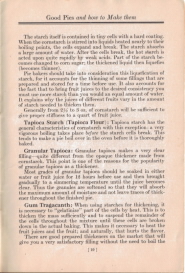 The starch itself is contained in tiny cells with a hard coating. When the cornstarch is stirred into liquids heated nearly to their boiling points, the cells expand and break. The starch absorbs a large amount of water. After the cells break, the hot starch is acted upon quite rapidly by weak acids. Part of the starch becomes changed to corn sugar; the thickened liquid then liquefies (becomes thinner).
The starch itself is contained in tiny cells with a hard coating. When the cornstarch is stirred into liquids heated nearly to their boiling points, the cells expand and break. The starch absorbs a large amount of water. After the cells break, the hot starch is acted upon quite rapidly by weak acids. Part of the starch becomes changed to corn sugar; the thickened liquid then liquefies (becomes thinner).
Pie bakers should take into consideration this liquefication of starch, for it accounts for the thinning of some fillings that are prepared and stored for a time before use. It also accounts for the fact that to bring fruit juices to the desired consistency you must use more starch than you would an equal amount of water. It explains why the juices of different fruits vary in the amount of starch needed to thicken them.
Generally from 2 1/2 to 3 oz. of cornstarch will be sufficient to give proper stiffness to a quart of fruit juice.
Tapioca Starch (Tapioca Flour): Tapioca starch has the general characteristics of cornstarch with this exception: a very vigorous boiling takes place before the starch cells break. This tends to make a pie boil over in the oven before it is thoroughly baked.
Granular Tapioca: Granular tapioca makes a very clear filling–quite different from the opaque thickener made from cornstarch. This point is one of the reasons for the popularity of granular tapioca as a thickener.
Most grades of granular tapioca should be soaked in either water or fruit juice for 12 hours before use and then brought gradually to a simmering temperature until the juice becomes clear. Thus the granules are softened so that they will absorb the maximum amount of moisture and not leave traces of thickener throughout the finished pie.
 Gum Tragacanth: When using starches for thickening, it is necessary to “gelatinize” part of the cells by heat. This is to thicken the mass sufficiently and to suspend the remainder of the cells throughout the mixture until these cells are broken down in the actual baking. This makes it necessary to heat the fruit juices and the fruit; and naturally, that hurts the flavor.
Gum Tragacanth: When using starches for thickening, it is necessary to “gelatinize” part of the cells by heat. This is to thicken the mass sufficiently and to suspend the remainder of the cells throughout the mixture until these cells are broken down in the actual baking. This makes it necessary to heat the fruit juices and the fruit; and naturally, that hurts the flavor.
There are good prepared thickeners on the market that will give you a very satisfactory filling without the need to boil the juice. These thickeners are savers of time and labor. While they are more costly than the starches, you will sometimes find that they will not increase the real cost of the pie.
Gum tragacanth may be used as a quick cold thickener. Its price varies from 50 cents to $1.70 per pound. Naturally, with this wide price range goes a corresponding difference in the characteristics of the gum. High-grade edible gum tragacanth is pleasant to taste and will absorb considerable moisture; the cheaper varieties will not absorb as much moisture and they have a distinctly disagreeable flavor.
1 oz. of the high-grade gum will thicken 1 qt. of juice to proper consistency. Mix it thoroughly with the necessary sugar; add this gradually to the juice while stirring.
1 oz. of the cheaper grade gum would spoil the flavor of the fruit. However, in smaller quantities the cheaper gum will thicken the juice sufficiently so that it will hold cornstarch in suspension. This method of using both gum and starch makes a good cold filler at a reasonable cost: Mix 1/4 oz. gum tragacanth and 2 oz. cornstarch with 1 lb. sugar and stir into 1 qt. of fruit juice. (Either of the following proportions will give you practically the same results: 1/2 oz. gum and 1 1/2 oz. cornstarch; 3/4 oz. gum and 1 oz. cornstarch.)
Gum tragacanth does not dissolve readily. Mixing with the sugar aids its dissolving and prevents lumping.
Flavor or Seasoning: Of course, most of the fruits used in pies are tasty in themselves. Nevertheless, a small amount of salt (say, 1/8 oz. to a No. 10 can of fruit) will accentuate the fruit’s flavor and show noticeable improvement.
Canning or drying affects the flavors of some fruits more than others. These fruits lack acidity. To gain the desired tartness to the pie fruit, add citric or tartaric acid (these acids are derived from the fruits themselves). Two parts of acid crystals and one part warm water makes a good solution. Use as much of it as you need. You will find either citric or tartaric acid, or a mixture of the two, satisfactory.
Spice plays an important part in the flavoring of custard and pumpkin pies. Mace, nutmeg, cinnamon and allspice are a few of the common spices used in both fruit and soft pies. Maple flavor, too, is useful in raisin fillings (to give an elusive aroma that is hard to identify).
While not in itself a flavor, Crisco deserves mention here. In lemon, cream, fresh apple, and other pies that need a small amount of fat for smooth texture and tenderness, Crisco’s absolute lack of flavor makes it ideal. For soft pies, melt the Crisco and stir it in; for fresh apple pies, dot the fruit with small pieces of Crisco.
 Here is most of page 18 of the vintage recipe booklet “Good Pies & How To Make Them” that was published in 1928 by Crisco.
Here is most of page 18 of the vintage recipe booklet “Good Pies & How To Make Them” that was published in 1928 by Crisco.
To review all pages in this booklet, simply visit the Crisco: Good Pies & How To Make Them Category and click on a page title to review that section.
There are scans available of each page, just click the images to view a full size copy.
Soft Fillings
In general there are two classes of soft pies: Those with cooked fillings placed in already-baked shells; those filled in the oven and baked with the shell.
 Cooked Fillings: Most bakers have a number of customers who want really good soft pies of the “cream” type. They are willing to pay a just price.
Cooked Fillings: Most bakers have a number of customers who want really good soft pies of the “cream” type. They are willing to pay a just price.
These fillings are flavored to suit and then cooked with cornstarch to thicken. You can make very rich cooked fillings, with a true home-made flavor, by using eggs, or egg yolks and Crisco, in them.
Baked Fillings: In the manufacture of custard pies, eggs are mixed with milk, flavored with spice and sugar and this is then cooked. To produce a custard pie with lower material cost, cornstarch is sometimes used to replace part of the eggs.
The wide range in quality of custard pies found in various bakeries may be explained from a comparison of the amounts of ingredients given in numerous formulae on basis of one quart milk.
1 qt. milk
2 to 6 eggs
3 to 8 ozs. sugar
none to 4 ozs. cornstarch
1/8 oz. salt
flavoring to suit
It seems needless to state that the formula calling for 2 eggs requires 4 ozs. cornstarch while that of best quality takes 6 eggs and no starch.
We would like to make emphatic our sincere belief that the big pie business will be won by those bakers who strive for excellence, rather than for cheapness.

